Shrouded in Sanity is a horror-themed action RPG with some minor balance issues and a few too many dead ends, yet a satisfying combat system and a great sense of atmosphere supported by plenty of lore make this a surprisingly enjoyable experience. Even though this is a fairly short game, especially if you know where to go, a New Game+ mode, multiple endings, and a completely open map make Shrouded in Sanity highly replayable regardless of if you’re going for a speedrun or simply aiming for a new ending. The upcoming semi-sequel, Usurper, will almost certainly be the better game of the two, Shrouded in Sanity has more than enough going for it to stand on its own.
Our protagonist is silent, undead, has amnesia, and looks a whole lot like a 2D version of Sephiroth, complete with a rather long sword cane called an Iaito blade. Aside from the whole undead thing, this sounds like a massive amalgamation of protagonist cliches, but the writing is actually rather good. The game begins in 1897 in an alternate version of Britain where at least part of the country has been overtaken by otherworldly entities and a deadly fog; things aren’t exactly going well to say the least.
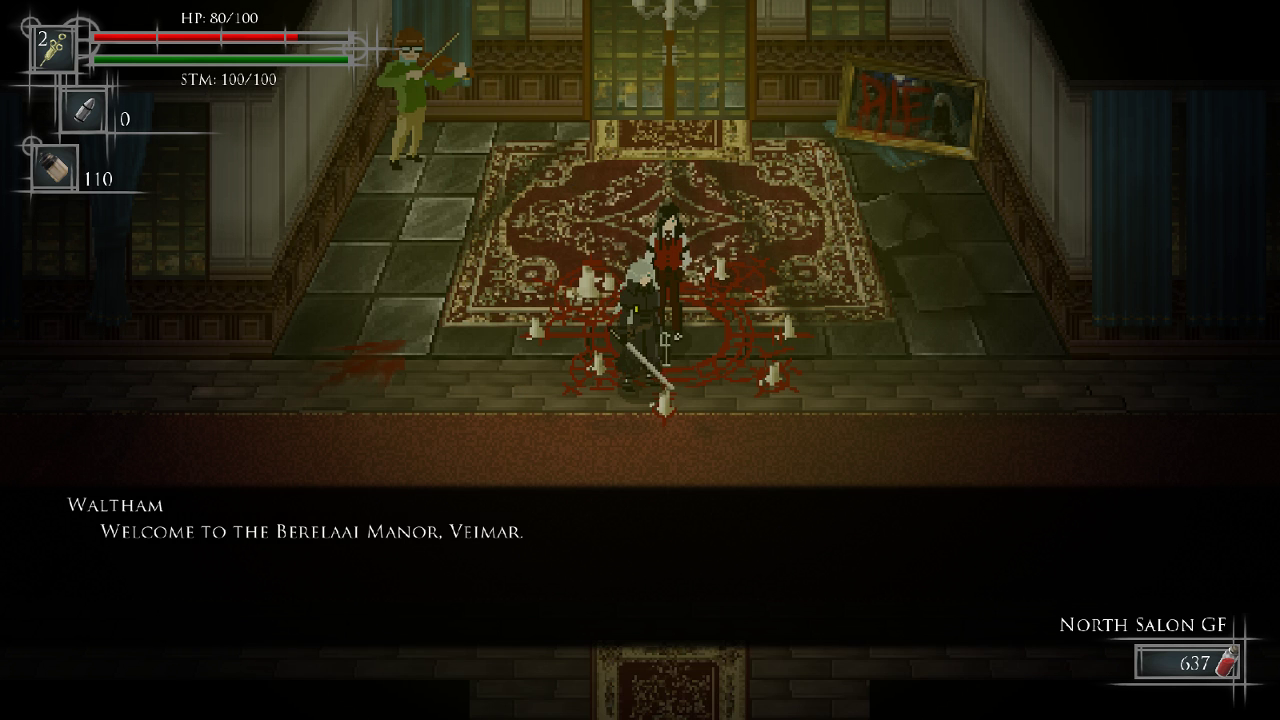
More specifically, the first scene involves our newly-revived protagonist being offered a rather suspicious contract by a demon named Waltham in which they will become a “Veimar” to destroy the source of the fog in exchange for freedom after this task is completed; players can choose to reject the contract, though doing so immediately ends the game (and nets you an achievement). After this initial setup and a brief, optional tutorial, the rest of the game takes place in the Berelai Manor and from there you’re free to explore just about everywhere.
You don’t unlock any new weapons or abilities throughout the game, but that’s not really an issue since you already start with a rather extensive set of skills heavily inspired by Dark Souls (it’s even mentioned as a source of inspiration in the Steam description). To begin with, everything works on a stamina system. If you’re not careful you can go into negative stamina, at which point you won’t be able to do much of anything other than walk until it recharges a bit, though I found the starting amount of stamina to be generous enough that I never upgraded it. For mobility, you have access to a stamina-draining run and a dodge roll which grants invincibility frames. When it comes to defense, you can guard to fully block melee attacks at the cost of stamina and parry enemy attacks while guarding to stun them. However, the most important abilities are you attacks.
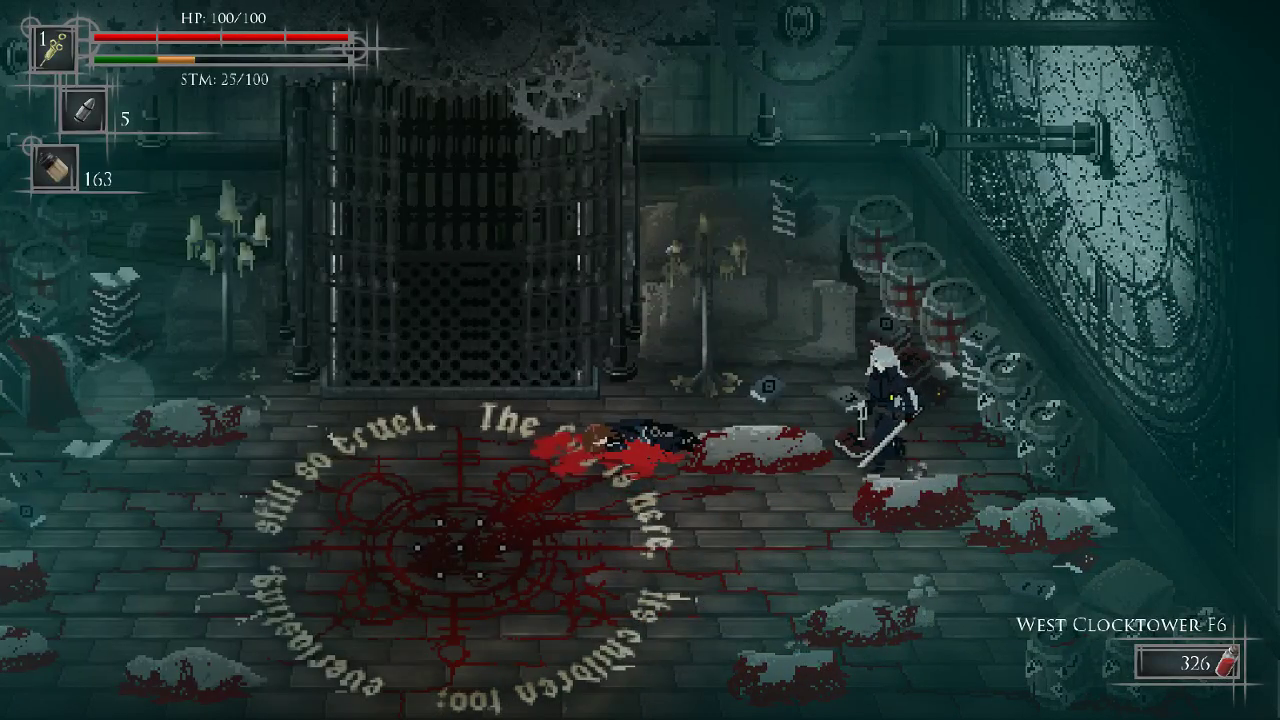
You have three main types of attacks at your disposal. First, you have a gun with a limited supply of bullets. Enemies occasionally drop more bullets, but they also simply refill when you save or die and you can upgrade your carrying capacity. The gun deals very little damage and there’s no way to make it stronger, but its strength lies in its ability to stun enemies if you hit them during a window before certain attacks when they flash blue. You also have a standard sword slash at your disposal which has a nice bit of Y-axis range so you don’t need to be perfectly lined up with enemies horizontally to hit them. This slash combo can be spammed as long as you have the stamina for it and there are variants for slashing while running or rolling, making it a simple yet effective attack.
Your final ability is undeniably the most important one. I’m referring to none other than your heavy sword slash attack. Even though it has a long delay, this ‘melee’ attack has a ridiculously massive amount of range and results in an equally impressive amount of damage. The range is the crucial part here as it outclasses the melee attacks of any enemy in the game, included those of bosses. The delay is virtually trivial because of how much space you’re allowed to put between yourself and your target; you always have plenty of time to cancel out of your attack and dodge roll to safety even when up against the fastest of melee attackers. As someone who rarely makes use of slow, heavy attacks in games, I was surprised at just how much fun this particular attack was to use. It’s the strongest, most entertaining tool at your disposal, but it’s also a somewhat problematic one.
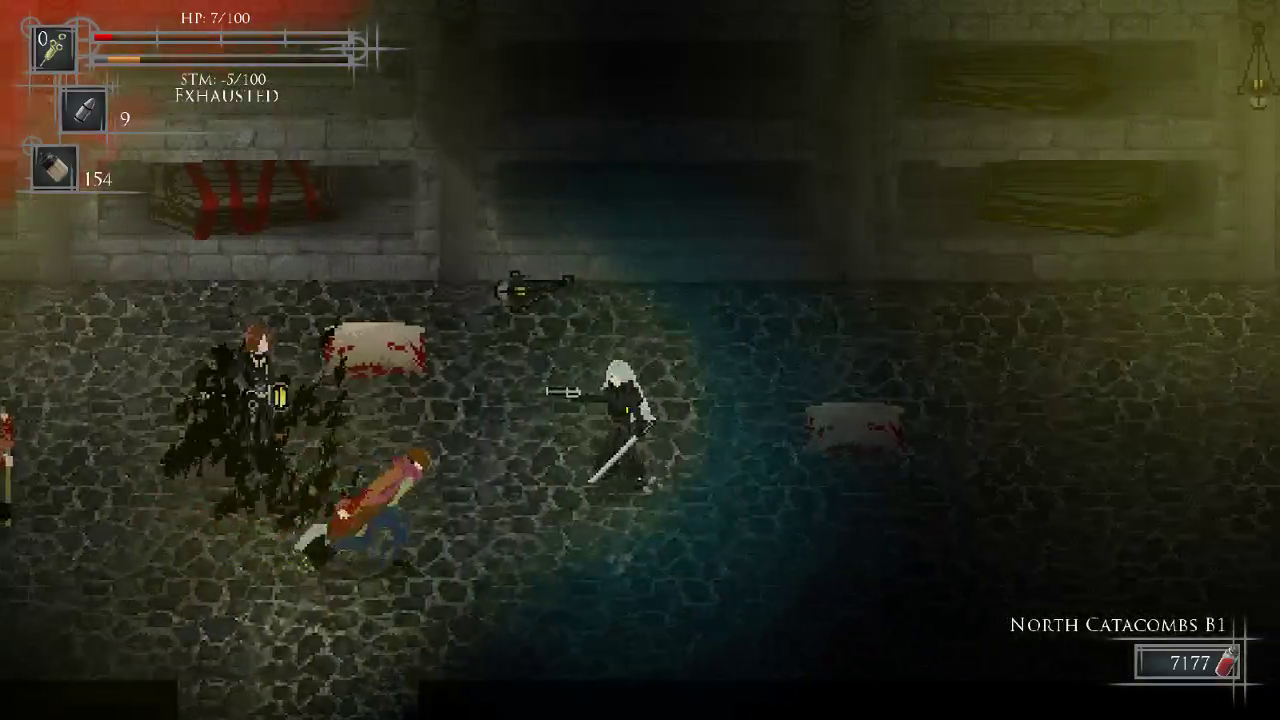
Your heavy attack is a bit too good for its own good. Thanks to the inherently defensive nature of this attack’s range, I never once felt the need to make use of the parry or even the block during my time with the game, including on New Game+ difficulty. Staying outside of an enemy’s range and dodge rolling if they started to lunge at me always felt like the safer option. Similarly, your normal attack is good, but enemies hit hard and, unless an enemy is stunned or nearly dead, the extra speed never makes up for the range and damage of the heavy attack, especially when up against bosses with fast attacks and/or strong counters.
The impact of this attack extends to Shrouded in Sanity‘s leveling system where you can choose between increasing your stamina, health, max injector (healing potion/Estus Flask) count, or sword damage. The other options aren’t useless, but putting all or most of your points towards boosting damage becomes the obvious choice. Some enemies and bosses, including the final boss, also just don’t seem to be balanced to take the heavy slash’s range into account as their attacks are focused near them and grant them little mobility; attacks which would pose a serious danger to players using normal slashes render these enemies virtually harmless and utterly vulnerable for extended periods of time for anyone relying on heavy attacks. All of this isn’t to say that heavy attacks trivialize the game, I still died plenty of times, or that the heavy attack shouldn’t exist, it’s far too much fun to use, but your skills and those of your enemies simply feel like they could have been better balanced to take the significance of this attack into account.
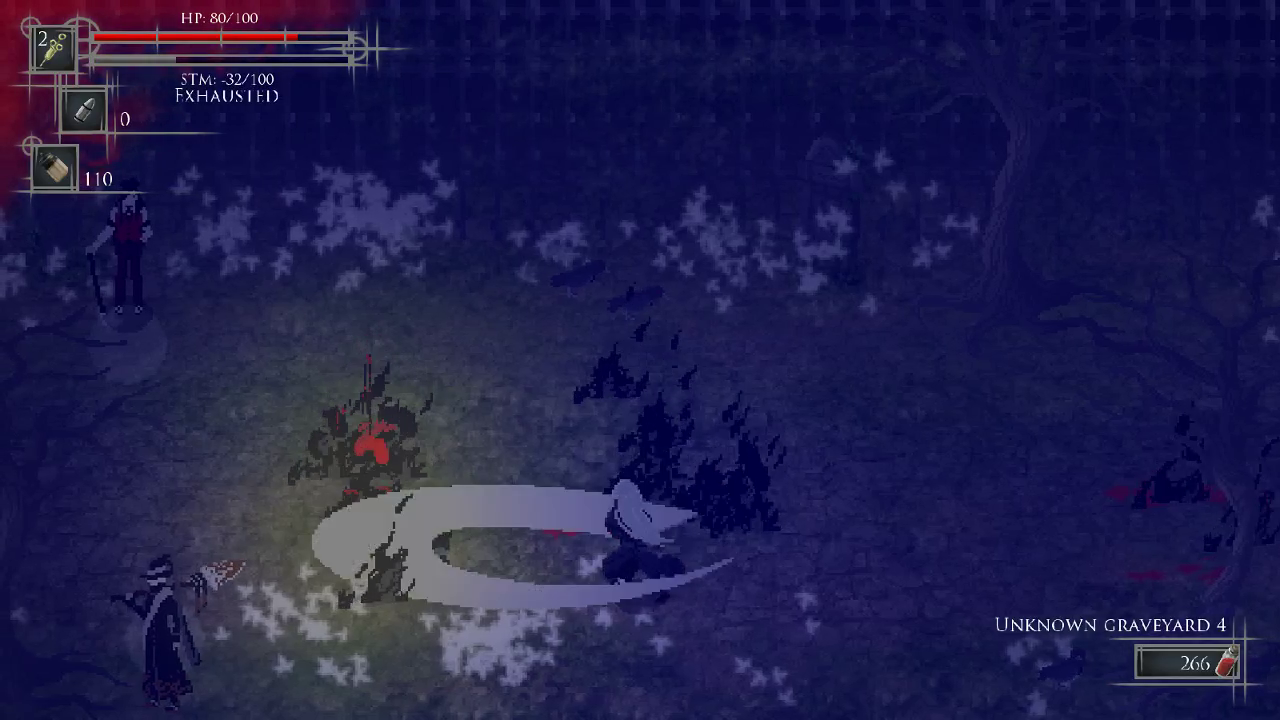
I mentioned earlier that you’re free to go nearly anywhere after the tutorial and this is one of Shrouded in Sanity‘s biggest strengths. You start in a hub room in the center of Berelai Manor’s first floor where you can talk to Waltham to fully heal and reset enemy spawns. From the hub you can go up or down and each of these directions in turn leads to branching paths around the first floor, outside the building, and upstairs. The ultimate goal is to find and defeat four knights to open the path to the final boss, but you are given no guidance as to where these knights are and you can fight them in any order.
Though there are no new weapons or abilities to find, butlers provide a reason to explore the manor beyond hunting down the bosses. While you can extract ‘vitae’ from enemy corpses to upgrade your bullet capacity and a few other things, the primary way of leveling up is through cashing in Yth Stones. You need three Yth Stones to upgrade stamina, health, melee damage, or injector capacity and, while you can buy these for very large amounts of vitae or find them as extremely rare enemy drops, the primary way to obtain them is through hunting down the butlers scattered throughout the manor. They aren’t much stronger than other enemies, but these butlers always drop a Yth Stone or, in a few cases, a key (more on those later) and they never respawn.
This somewhat roundabout system for leveling plays into strengthening the open exploration. On top of giving players the freedom to choose where they explore, Shrouded in Sanity is good at letting players choose how they explore due to the sanity system. Certain actions will lower the protagonist’s sanity over the course of the game, including cashing in Yth Stones to level up. Having low sanity isn’t necessarily a bad thing, it won’t lock you out of any endings and it even leads to a few secrets, but it does affect the enemies.
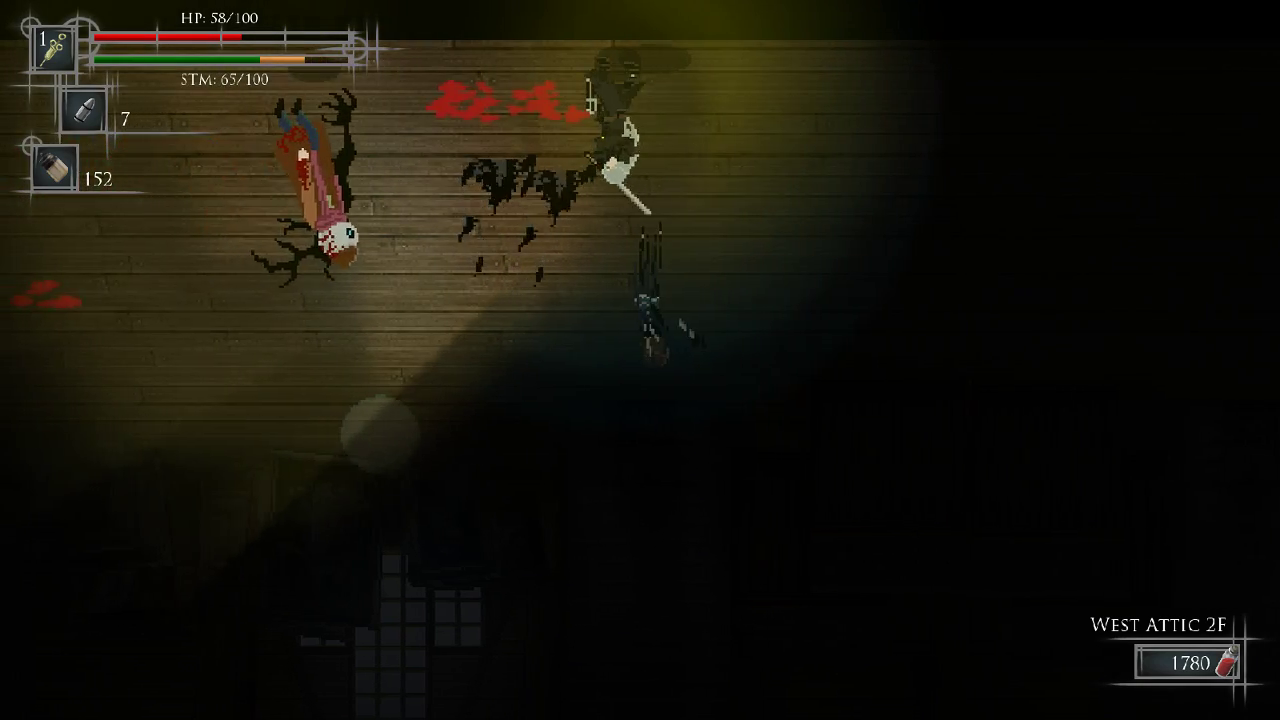
Most enemies have two forms they can take, a human version and a demonic version. When your sanity is high you’ll mostly encounter human enemies such as maids swinging knives and gardeners leaping at you with axes. As your sanity drops the chance of encountering the demonic versions rises. These alternate versions aren’t necessarily more dangerous, but they are definitely more involved. For example, those maids I mentioned can appear as nightmarish octopus creatures capable of spawning tentacles anywhere in the room and the gardeners turn into flying eye monsters capable of inverting the screen and interrupting your actions. As such, the overall difficulty of the game scales with you, at least to a certain degree. Gaining as many levels as possible to make boss fights easier or minimizing your Yth Stone usage are equally valid strategies.
Shrouded in Sanity can vary a lot in length, which is just one of the various factors contributing to its high replay value. Paths frequently interconnect and every boss has at least two routes leading to it. If you know where to go, you can reach any given boss from the central hub in about a minute. There are no cutscenes and nor mandatory dialogue aside from the opening and ending, making this a game which can be, and has been, completed in under ten minutes. Alternately, seeking out every butler, talking to every NPC after defeating each boss, and scouring every room in the manor for lore takes about two to three hours on a first run.
Individually, each room in Shrouded in Sanity is put together well enough, but the map as a whole leaves something to be desired. On the plus side, there are little graphical details and bits of lore in virtually every single room which add to the atmosphere or shine some light on the plot and the setting. However, the ways in which rooms interconnect are often confusing to say the least.
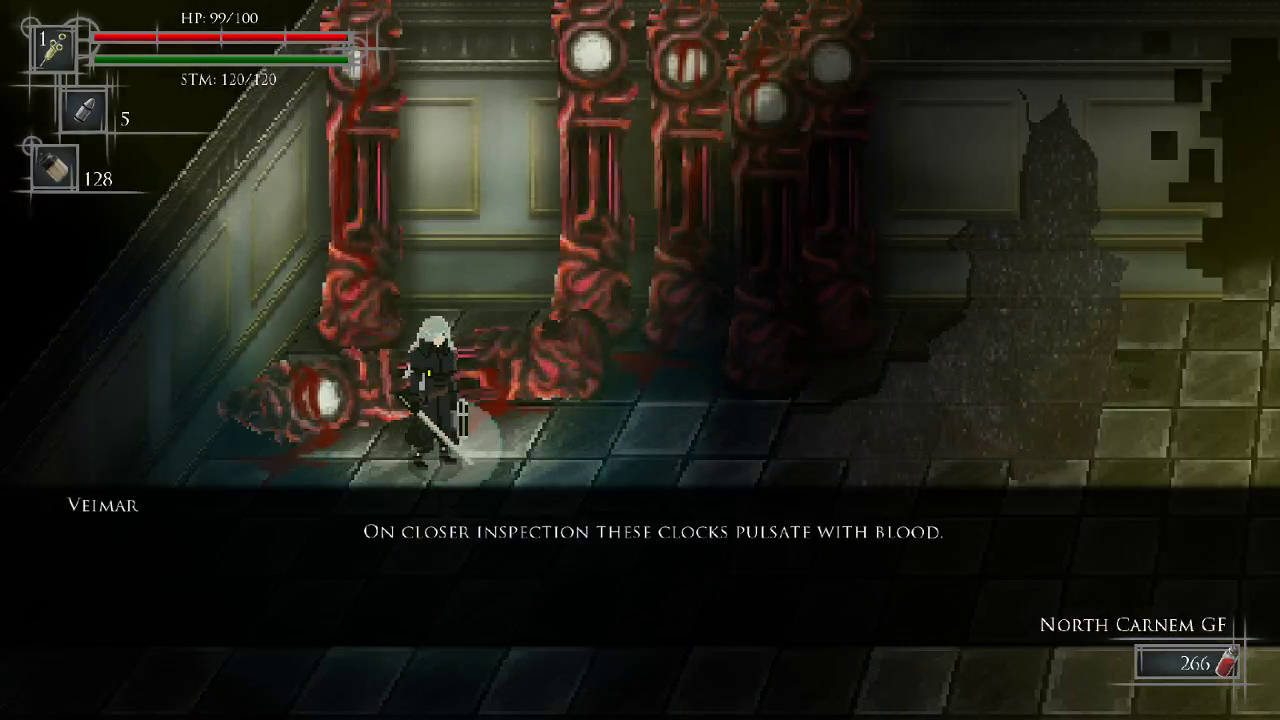
To begin with, the keys dropped by some of the butlers are virtually useless. The areas these keys unlock are never near the butlers which dropped them and, with one exception, these only serve to create new paths between rooms you could already reach. Calling these new paths shortcuts would be disingenuous as they are rarely helpful, often connecting an out of the way room to a room near a boss you’ve likely already killed before finding the key. There’s always a faster path leading to the bosses from the hub and there’s a good chance that you’ve already seen everything in the more out of the way rooms while hunting down butlers for keys and Yth Stones.
A larger issue than the mostly pointless keys is the map layout itself. The manor isn’t all that big, you can easily see all of it within three hours after all, but it can be incredibly confusing to navigate. It’s common to enter a door at the top or bottom of one screen and find yourself in front of a door on the left or right side of the next room or vice versa. At other times you might come across a large loop of rooms which doesn’t feel like it lines up properly with the rooms around it. From a lore perspective, this might tie in with the protagonist’s questionable sanity or the manor’s own distorted sense of time and space.
More likely, this was more of a gameplay-based decision to flip the perspective of any rooms which would technically be more vertical on the map to be horizontal from the player’s point of view since so many of your own attacks and those of enemies are designed with a long horizontal axis in mind. If this sounds strange, just try to imagine playing a beat-em-up with long, vertical paths; it wouldn’t work because a perspective where characters can only ever be facing left or right is designed for primarily horizontal play. Regardless of the reason behind the decision to apparently flip several rooms 90°, at the end of the day it still results in some needlessly confusing mapping and it would have made more sense to have designed the manor in such a way that this change in perspective wouldn’t be necessary in the first place.
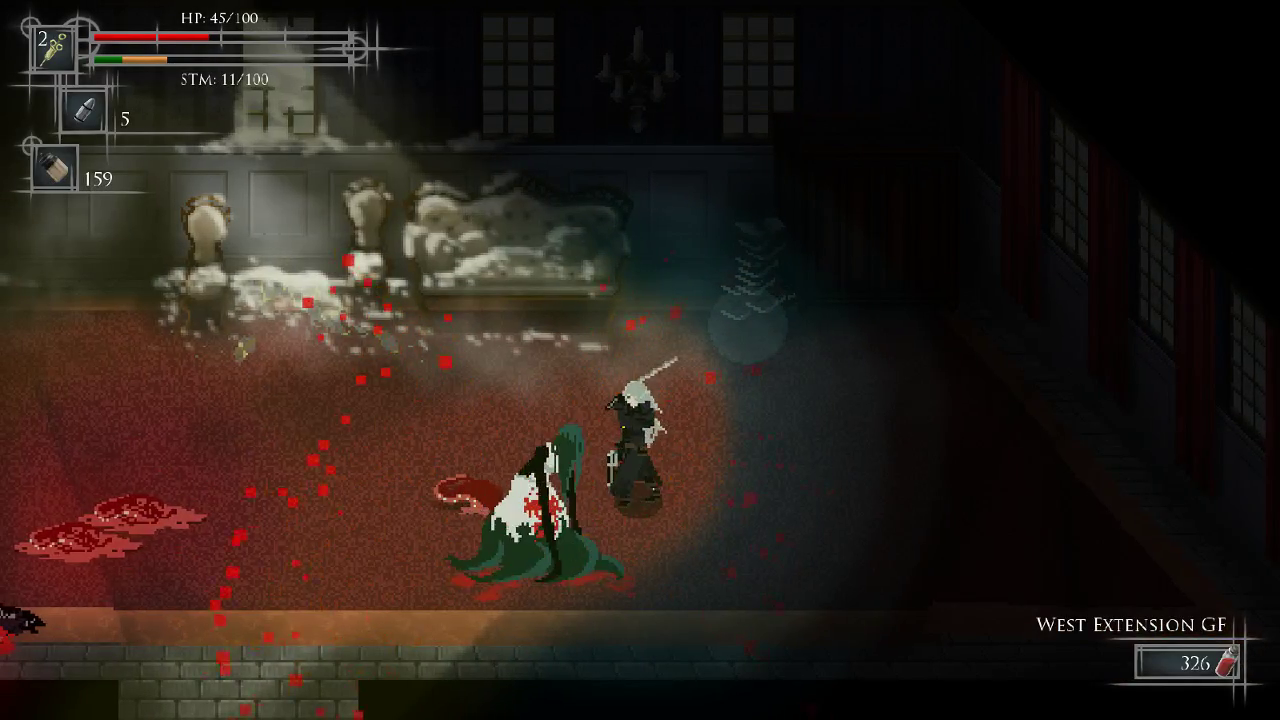
Another, more minor, issue with the mapping is that a bit too much of the manor feels pointless. This is where the game’s lack of upgrades beyond Yth Stones somewhat stabs it in the foot. I like passive storytelling through bits and pieces of lore, but it can be disappointing when a room contains nothing except some enemies and a snippet of lore. Even more extensive portions of the manor as a whole may have one or two butlers and otherwise put you through quite a bit of danger for nothing except some worldbuilding. This lack of a tangible payoff can be especially disheartening whenever the lore you find only faintly ties in with the plot of Shrouded in Sanity and instead basically boils down to “Go play Usurper to find out whatever this means!” As for the enemies you see along the way, the vitae you harvest from their corpses simply isn’t all that useful other than in very large quantities and they usually only drop bullets or battery power for your light (battery power drains so slowly that it’s a complete nonissue); there is very little reason not to just run past the enemies in a room unless there’s a butler or some lore.
Getting back on the positive side of things, this game really does have a ton of replay value. To begin with, there are four different endings and it will take at least two runs to see all four. If you care about lore, there are enough NPC’s scattered around with different bits of dialogue based on your progress and/or sanity that you’ll probably need at least two runs to see all of it. On the other side of things, this is also a great game for speedrunners due to the short time it takes to reach each boss and the bosses themselves pose a serious challenge if you haven’t leveled up.
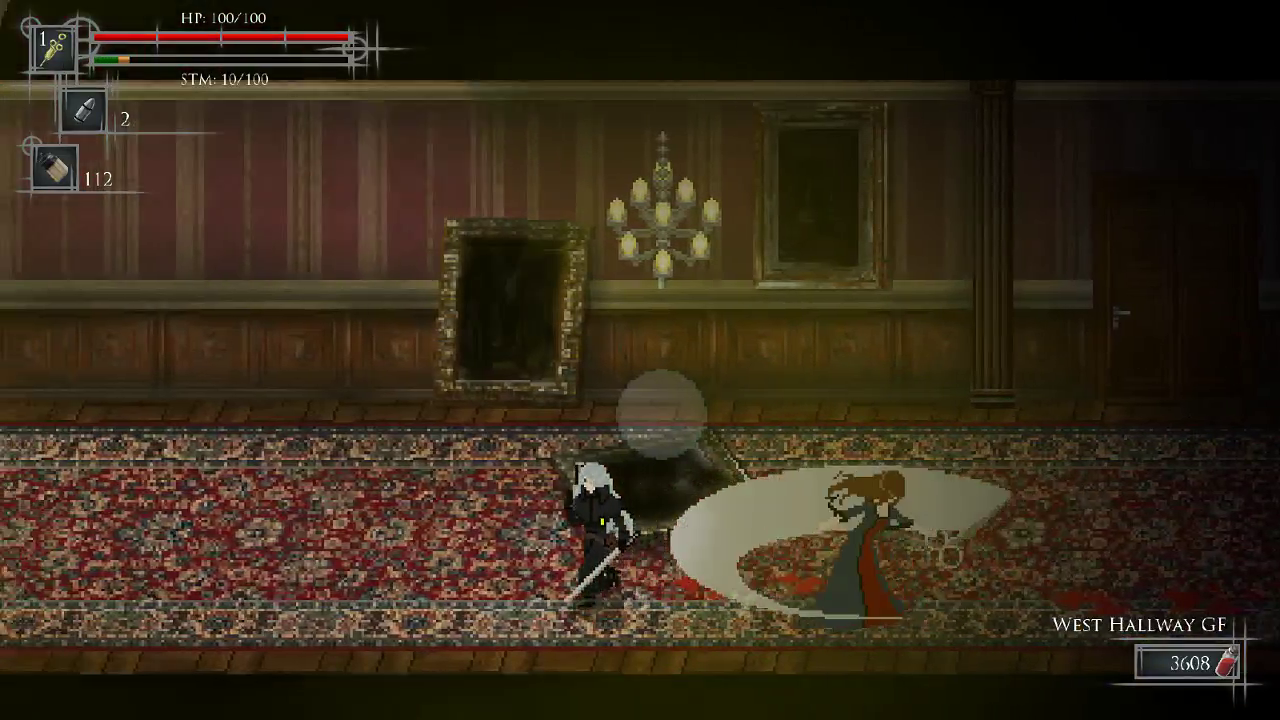
A New Game+ mode also exists which lets you start with your level intact and greatly boosts the damage and health of enemies while also throwing tougher stuff at you right off the bat, including immobile, invincible orb-shaped things which spawn fire around them when you get close. Entering New Game+ has the added benefit of unlocking two gauntlets, one which is divided into waves with a boss every fifth wave and another which is a chaotic and rather ridiculous clash against every boss in the game at once.
Last, but by no means least, there’s a “4 Knights” mode where you can choose to start a new game as any of the four knight bosses, each of which has their own unique attacks. The knights don’t have quite as much versatility as the standard protagonist, but they are absurdly strong right from the start. The knights are fun to play as, though I do wish they weren’t quite as strong as they are since their strength definitely puts the 4 Knights mode into the realm of “just for fun” rather than offering viable alternative playstyles.
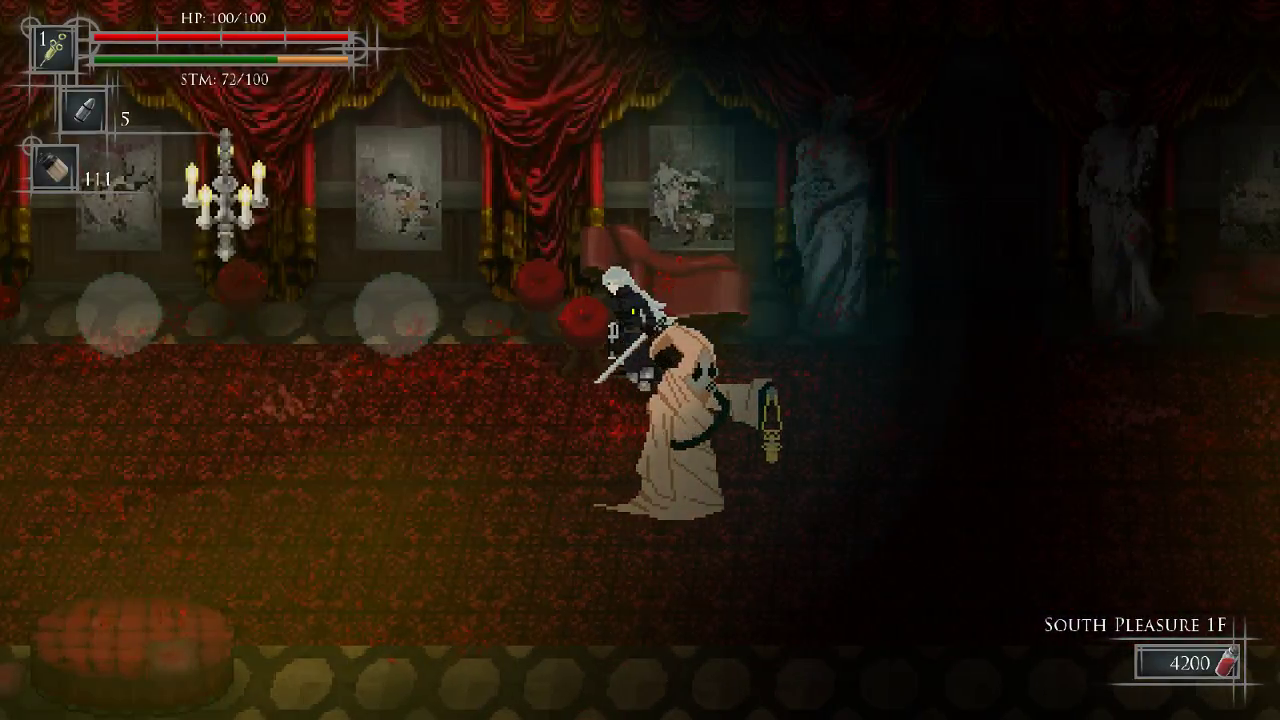
The setting itself is also a fantastic take on cosmic horror elements. This isn’t a scary game by any stretch, though there’s plenty of blood and some gore, just enough to create a dark setting without dipping into excessive or edgy territory. The game also does a great job of slowly parceling out small hints as to just who the protagonist is and what happened in the manor; the opening and the various endings provide enough information on their own for players to grasp the most basic outline of the plot while the lore throughout the manor fills in many of the details. It’s also worth noting that for a game with a good amount of text I didn’t notice too many spelling errors with the only particularly notable one being when you save and “relaign” time.
Before bringing things to a close, there are a few last points I want to address. First, the amount of work that went into designing the manor is incredible. Even if I have some issues with the overall map layout, there are a ton of unique environmental assets everywhere in the manor which really enhance the setting; each room feels like it serves (or served) a purpose as part of the manor beyond being a place to fight enemies in.
The soundtrack is appropriately subdued other than during some of the boss fights, in which it just as appropriately becomes louder and more intense or menacing, though I wish there was more variety while exploring the manor and the music noticeable restarts every time you enter a new room. I also liked most of the boss fights with Hito in particular being a fun fight as at certain points in the fight he disappears to snipe at you while normal enemies attack, making it a more involved fight than usual, though the final boss can be a bit too easy to cheese with heavy attacks and Saragat can more or less be outright tanked with a few attack upgrades even though his cloning gimmick is cool.
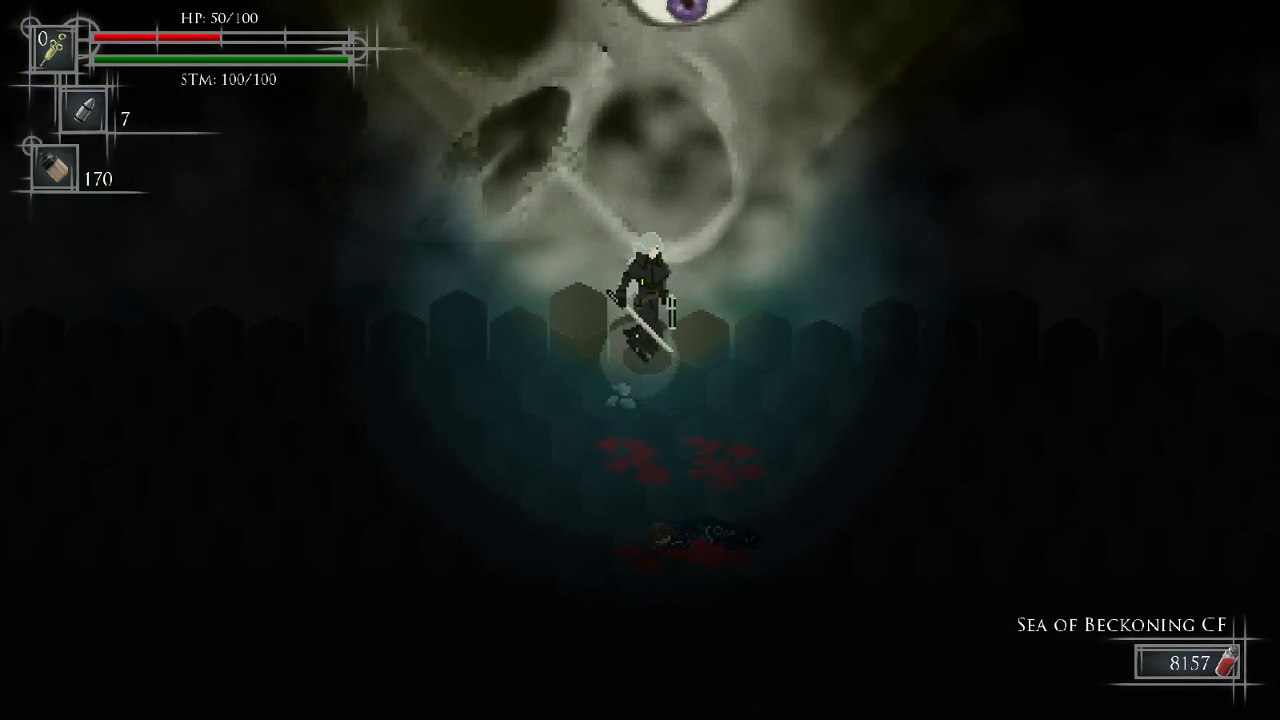
Shrouded in Sanity certainly has its fair share of rough spots, but none of them come close to being game-breaking. In fact, I went into this game feeling rather skeptical and came away very pleasantly surprised and more excited for Usurper than I had been, even though they are rather different games in terms of gameplay. Overall, Shrouded in Sanity is an entertaining and, in some ways, highly malleable game which doesn’t mind blatantly applying good mechanics from its sources of inspiration to its own systems.